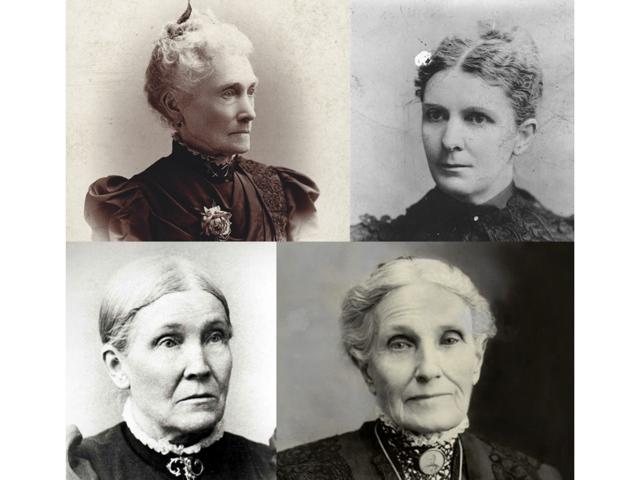 Download Photo
Download PhotoThis story appears here courtesy of TheChurchNews.com. It is not for use by other media.
By Kenneth Mays, Church News
One marched with the Mormon Battalion with her husband. Another was nursing her tiny newborn when mobs came to their home. A mother, led by inspiration, worked to help her young son injured at Hawn’s Mill. There are women who sought to practice their faith and establish Zion and faced opposition that called for courage bolstered by their faith. Others saw a need, sought inspiration to fill that need and worked through challenges to see it through.
Here are nine women who were part of the early days of The Church of Jesus Christ of Latter-day Saints, with information about their lives, including notable experiences, and photos of sites connected to them.
Amanda Barnes Smith: Healing After Hawn’s Mill
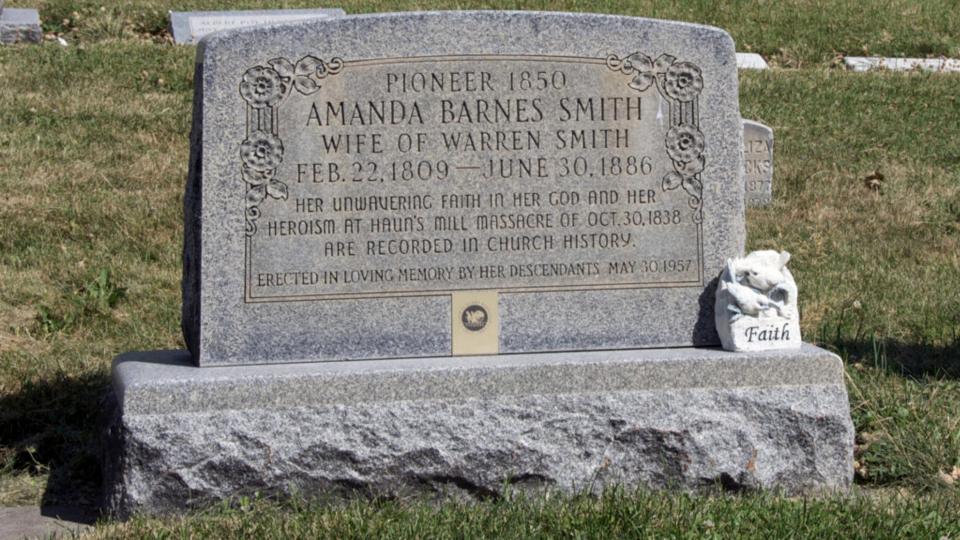
9-women-in-Church-history
The grave marker of Amanda Smith Barnes in Richmond, Utah, who died in 1886. Her husband, Warren, and son Sardius, 10, were killed at Hawn’s Mill. Another son, Alma, was badly injured and his hip blown out. She was led by revelation how to deal with Alma’s injuries. Photo by Kenneth Mays, courtesy of Church News.All rights reserved.Who: After joining the Church in 1831 in Amherst, Ohio, Amanda Barnes Smith and her family moved to Kirtland. They suffered financial catastrophe and lost everything because of the failure of the Kirtland Safety Society in 1837-38. The Smiths decided to join the body of Saints in Missouri.
Experience: While passing through Hawn’s Mill in October 1838, members of Amanda’s family were among the victims of a mob that attacked the settlement. Her husband, Warren, and 10-year-old son, Sardius, were both shot to death. Her son Alma had his hip blown away and was near death. Even with the shock and unimaginable grief that engulfed her, Amanda was led by revelation to deal with little Alma’s hip. She followed a course of action that she never would have known without divine help. After weeks of lying on his face, Alma eventually recovered.
As threats from the mob continued through the next month, Amanda sought help from the Lord, seeking strength to continue on. She heard a voice give these words:
That soul who on Jesus hath leaned for repose,
I cannot, I will not desert to its foes:
That soul, though all hell should endeavor to shake,
I’ll never, no never, no never forsake.
They are from the seventh stanza of “How Firm a Foundation,” “Hymns,” No. 85, and included in the 1835 hymnal. Her experience is also detailed in “I’ll Never Forsake,” by Alex Baugh, part of “Women of Faith in the Latter Days, Vol. 1: 1775-1820″ by Richard E. Turley and Brittany Chapman Nash.
Amanda remarried and her second husband had the same name as her first husband, though they weren’t related. Their marriage ended in divorce.
In death: Amanda spent the rest of her life in Salt Lake City. She was active in the Church as her health allowed. For the last few weeks of her life, she stayed with a daughter in Richmond, Cache County, Utah. She died in 1886 and was buried in the Richmond Cemetery.
Drusilla Dorris Hendricks: Protecting Family
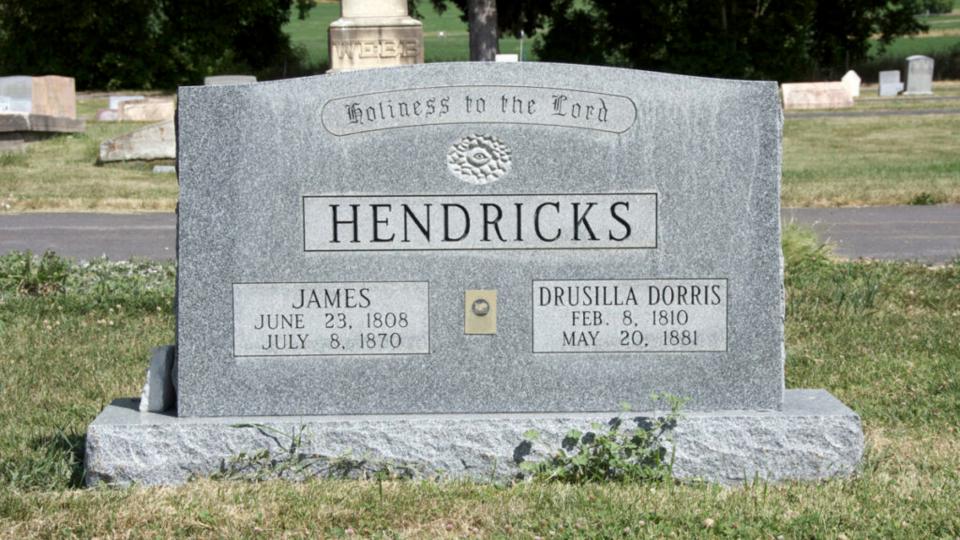
9 women in Church history
The headstone of Drusilla Dorris Hendricks and her husband, James Hendricks, in Richmond, Utah. James was injured during the Battle of Crooked River in Missouri and paralyzed from the waist down. Mobs later broke into the Hendrickses’ Missouri home looking to kill him and Drusilla told them they would have to kill her first. The Hendrickses later made their way to Nauvoo and later to the Salt Lake Valley. Photo by Kenneth Mays, courtesy of Church News.All rights reserved.Who: Drusilla and James Hendricks joined the Church in 1835 in Tennessee and were living in Missouri by 1836.
Experience: During the Battle of Crooked River, James was shot in the neck and paralyzed from the neck down. He could speak but had no feeling anywhere else in his body. The mobs were still raging. At one point, they broke into the house where Drusilla was watching over her husband and nursing her baby. The mob members said they were there to kill James. Drusilla told them they would have to kill her first, as shared in “Women’s Voices: An Untold History of the Latter-day Saints, 1830-1900,” by Jill Mulvay Derr, Audrey M. Godfrey and Kenneth W. Godfrey.
James improved somewhat but Drusilla was the one who had to get the family out of Missouri and on to Illinois. She had to lift James at least 50 times a day, which strained her every nerve. During this period, James’ body broke out into countless sores, distressing him greatly. They reached a point where they had no food whatsoever — neither meat, bread nor vegetable. In a moment of despair, she heard a voice say, “Hold on, for the Lord will provide.” A number of people were inspired to meet their needs, as shared in “The Spirit of the Lord Has Buoyed Me Up,” by Susan Easton Black that’s part of the “Women of Faith in the Latter Days, Vol. 1: 1775-1820.” They eventually had a brick house in Nauvoo, Illinois, which is extant.
Heading west, Drusilla’s son served in the Mormon Battalion. She and the rest of her family reached the Salt Lake Valley in 1847. James continued to improve and served as a bishop. They moved to Richmond, Cache County, in 1860.
Death: James died in 1870, Drusilla died in 1881 at the age of 71. Both are buried in the Richmond Cemetery. Black cites Drusilla as follows: “The Gospel is true … I have rejoiced in it through all my trials, for the Spirit of the Lord has buoyed me up, or I should have failed.”
Eliza Carter Snow: Facing a Missouri Mob
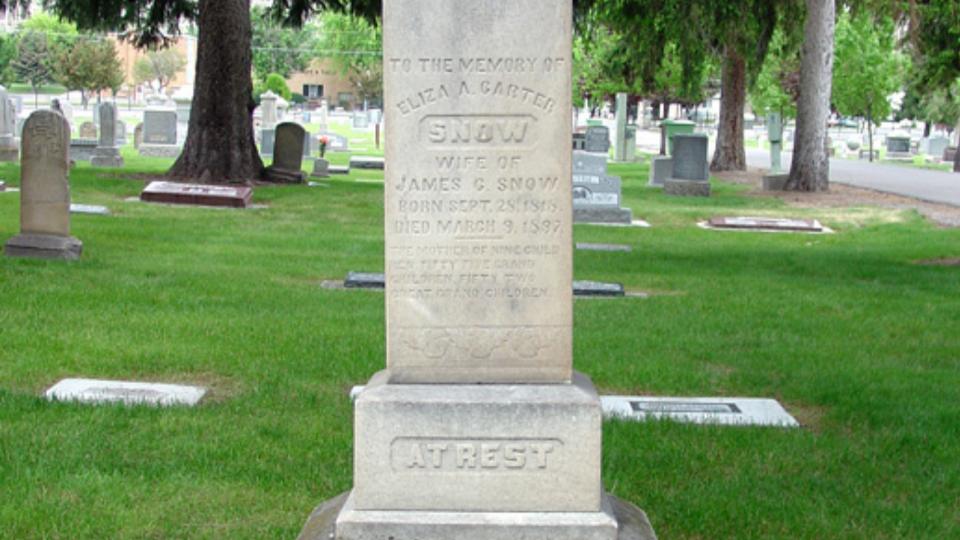
9 women in Church history
The grave of Eliza Ann Carter Snow in Provo, Utah. Eliza Carter Snow was living in Far West, Missouri, and her husband, James, was away when she went into labor. When a mob raiding homes in the area area came to her home, Eliza recognized one of the men, as he had taught her family the gospel. She called him by name and reproached him for his apostasy. He slunk away and called off the mob that was with him. Photo by Kenneth Mays, courtesy of Church News.All rights reserved.Who: Eliza Carter Snow was raised in Maine. She joined the Church and eventually moved to Missouri.
Experience: On October 30, 1838, the day of the massacre at Hawn’s Mill, Caldwell County, Missouri, Eliza gave birth to her first child, a baby daughter, Sarah Jane. Following is one of the versions of the experience, recorded in “Valiant in the Faith: Gardner and Sarah Snow and Their Family” by Archibald F. Bennett and Ella M. Bennett. See also Eliza Ann Carter Snow’s autobiographical sketch, located in the Church History Library.
“James [her husband] was forced under these circumstances to be away from his home during the first few days after the birth of his firstborn; and was absent on this day when the mob raided the houses. Diantha Billings, the midwife, had children of her own to protect, and she left Eliza Ann, as soon as the babe, which weighed only 2½ pounds, was born. The mob, led by John F. Boynton — onetime missionary to the Carter home in Maine and erstwhile Apostle — came right into the cabin where the sick and weakened mother and her helpless babe were left alone. She recognized the leader’s voice when he demanded:
“’Madam, how old is your baby?’
“’Reckon it for yourself,’” the intrepid mother retorted.
“She called John F. Boynton by name, and reproached him for his apostasy from the truth he had once taught her and her family. He slunk shamefacedly away, calling the mob off with him. To her courageous attitude both she and the child probably owed their lives.”
After fleeing from Missouri to Illinois, Eliza settled in Lima, Illinois, south of Nauvoo. Her home there was also burned to the ground by a mob.
Crossing paths: Eliza came west in 1852. Her husband, James, was captain of the company. While en route, company member Rebecca Winters died and was buried with her name inscribed on the rim of a wagon wheel near Scotts Bluff, Nebraska.
Death: Eliza died on March 9, 1897, at her home in Provo, Utah.
Ellis Reynolds Shipp: Pioneer Doctor

9-women-in-Church-history
Ellis Shipp was a Latter-day Saint woman who became a medical doctor. Photo courtesy of Church History Library.2021 Intellectual Reserve, Inc. All rights reserved.Who: As a girl of 5 years, young Ellis Reynolds Shipp traveled west with the James C. Snow Company of 1852. Near Scotts Bluff, Nebraska: “That night Rebecca Winters died. Grandmother Hawley took from her own chest of drawers material for her burial clothing. She and Ann sewed together through the dark hours. Ellis stood in the shivering night air beside her father [William], holding the lantern high so he could work, performing his own act of love and service. … When the time for burial came, William Reynolds brought forth his offering. He had chiseled Rebecca’s name on the old wagon tires. … This shall be the means of identifying this grave in years to come. Time would tell how true was his prophecy” writes Susan Evans McCloud in “Not In Vain: The inspiring of Ellis Shipp, pioneer woman doctor.”
Experience: Ellis spent time in the Beehive House and went to school with some of Brigham Young’s children. As a pioneer wife and mother, Ellis went back east to attend medical school at great sacrifice to her and her family. At home with her husband and children during a break between academic years, Ellis became pregnant and debated whether or not to continue on with her training. She would be alone at school to deal with delivery, caring for a newborn, final examinations and completion of her training beyond that. Two short episodes in that connection follow below:
“Back at school Ellis had to conserve what little money she had. In exchange for food, she began instructing a baker’s daughters in dressmaking. She was deeply touched when her young son sent her a letter with a pressed flower and a dollar he had earned.
“Worried that her pregnancy might end her schooling, Ellis prayed all one night to the Lord that she might have the strength to finish her classes before the baby was born. Ellis did not miss a single class! On May 25, 1877, the day after she passed her exams, she gave birth to a baby girl. Ellis was delighted to have a daughter, and she wrote in her diary: ‘It is to me the crowning joy of a woman’s life to be a mother’” as recorded in “Heroes and Heroines: Ellis Reynolds Shipp — Mother and Doctor,” by Julie Wardell in the April 1984 Friend magazine.
Death: Ellis delivered thousands of babies. She also trained many medical students, receiving many awards and honors. She died on January
31, 1939, at the age of 92. She was buried in the Salt Lake City Cemetery.
Jennetta Richards Richards: First Confirmed Member in England
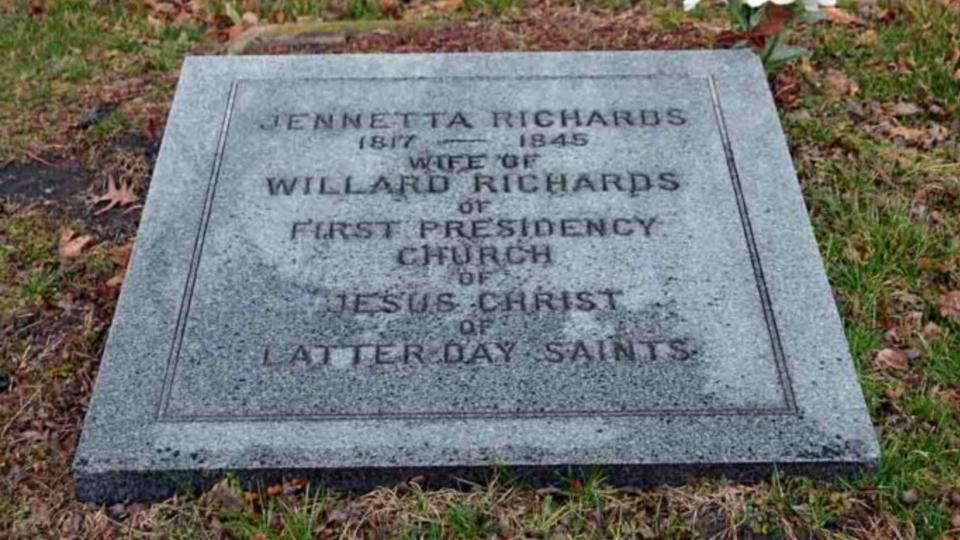
9-women-in-Church-history
The grave of Jennetta Richards Richards in Nauvoo, Illinois. Jennetta Richards was baptized in the River Ribble in England and confirmed at the waters’ edge. It’s believed that Jennetta is the first person confirmed a member of the Church in Great Britain. Photo by Kenneth Mays, courtesy of Church News.All rights reserved.Who: Jennetta Richards was a young woman from England who in the summer of 1837 met the first Latter-day Saint missionaries sent to Great Britain. This was just months after Queen Victoria ascended to the throne. Jennetta was living in the village of Walkerfold, Lancashire, where her father, John Richards, served as the minister of a small Protestant congregation. Mary Haskin Parker Richards lived in the vicinity and attended the church of Rev. Richards before her conversion (see “Picturing history: Sites connected to Jennetta Richards,” Deseret News, Feb. 7, 2017).
Experience: After hearing just two sermons preached by Elder Heber C. Kimball, Jennetta requested baptism. She was baptized in the River Ribble on Aug. 4, 1837, and confirmed at the water’s edge shortly thereafter. Though not the first one baptized, it is believed that she was the first person in England to be confirmed a member of The Church of Jesus Christ of Latter-day Saints, as shared in “My Soul Rejoices at the Thought,” by McCloud in “Women of Faith in the Latter Days, Vol 1: 1775-1820.”
Initially, Jennetta’s father opened his chapel to the Latter-day Saint missionaries but soon changed his policy because so many in the region were converting to this new religion. The Richards home and chapel are extant.
On the day Elder Kimball baptized Jennetta, he sent a message to Willard Richards, a bachelor, saying, “I baptized your wife today.” Elder Kimball’s prediction eventually became reality. Willard and Jennetta married Sept. 24, 1838. Willard Richards had been called to the Quorum of the Twelve in July of that same year (see Doctrine and Covenants 118:6), but he was not ordained to that calling until he was joined by other members of the Twelve on the second mission to Great Britain in 1840. Jennetta suffered extreme opposition from her family and others because of her baptism and marriage to Willard Richards, which is recounted in “Men With a Mission: The Quorum of the Twelve Apostles in the British Isles, 1837-1841″ by David J. Whittaker, James B. Allen and Ronald K. Esplin.
Elder Richards, Jennetta and a son, Heber John, left England for Nauvoo, Illinois, in April 1841. Jennetta stayed in Massachusetts while Willard established a home in Nauvoo. She arrived in late 1842. Willard was a witness to the martyrdom of the Prophet Joseph and Patriarch Hyrum Smith in 1844.
Death: Jennetta became ill during the summer following the martyrdom. She passed away in Nauvoo, Illinois, on July 9, 1845. After being moved twice, her grave is located near the sidewalk on the west side of Durphy Street between White and Hotchkiss streets in Nauvoo.
Mary Elizabeth Rollins Lightner: Saving Pages of the Doctrine and Covenants
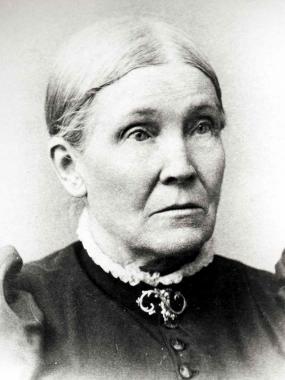
9-women-in-Church-history
A portrait of Mary Elizabeth Rollins Lightner. She was 95 when she died in 1913 in Minersville, Utah. While living in Jackson County, Missouri, in 1833, Mary Elizabeth Rollins and her sister Caroline helped save pages of the Book of Commandments by gathering pages and hiding in a nearby cornfield. 2021 Intellectual Reserve, Inc. All Rights Reserved.Who: Mary Elizabeth Rollins was born in 1818 in western New York. She later moved to Kirtland, Ohio, to live with her uncle, Algernon Sidney Gilbert. She joined the Church in fall 1830.
Experience: After attending a meeting where the Prophet Joseph Smith was speaking, Mary wrote:
“The Prophet was speaking when ‘all at once his countenance changed and he stood mute. He turned so white he seemed perfectly transparent. Those who looked at him that night said he looked like he had a searchlight within him, in every part of his body. I never saw anything like it on earth. I could not take my eyes away from him. He got so white that anyone who saw him would have thought he was transparent. I remember I thought we could almost see the bones through the flesh of his face. I shall remember it and see it in my mind’s eye as long as I remain upon the earth’” see “Studies in Scripture, Vol. 2: The Pearl of Great Price” edited by Kent P. Jackson and Robert L. Millet, page 49).
While living in Jackson County, Missouri, in 1833, “Mary and her sister Caroline saw an angry mob enter the two-story Church printing office near their home. Brother W.W. Phelps and his family, who lived in the building, were driven out. Their belongings were tossed into the street, and the printing equipment was destroyed. The mob soon emerged with a stack of paper on which had been printed the Book of Commandments (the first printing of what later came to be known as the Doctrine and Covenants) … Mary, standing nearby in the corner of the lot, was determined to save some of the copies. While the mob had their backs turned, Mary and Caroline dashed up, grabbed as many as they could carry, and hurried back behind the building. Some of the men turned around just in time to see the two girls and yelled at them to stop. Fearing for their lives, the girls ran through a gap in a wooden fence, raced into a cornfield, and hid on the ground lying on top of the sheets of paper …. Several times they could see the men’s feet as they walked among the cornstalks, but the girls were not discovered” (see “Sunbonnet Sisters: True Stories of Mormon Women and Frontier Life,” by Lenoard J. Arrington, pages 16-17, 20; and “Saints, Vol.1,” pages 177-179).
Death: Mary Elizabeth married Adam Lightner in 1835. They moved from place to place over the years seeking better employment. They eventually ended up in Utah. She died in 1913 in Minersville, Utah, at the age of 95.
Melissa Burton Coray Kimball: Marched with the Mormon Battalion
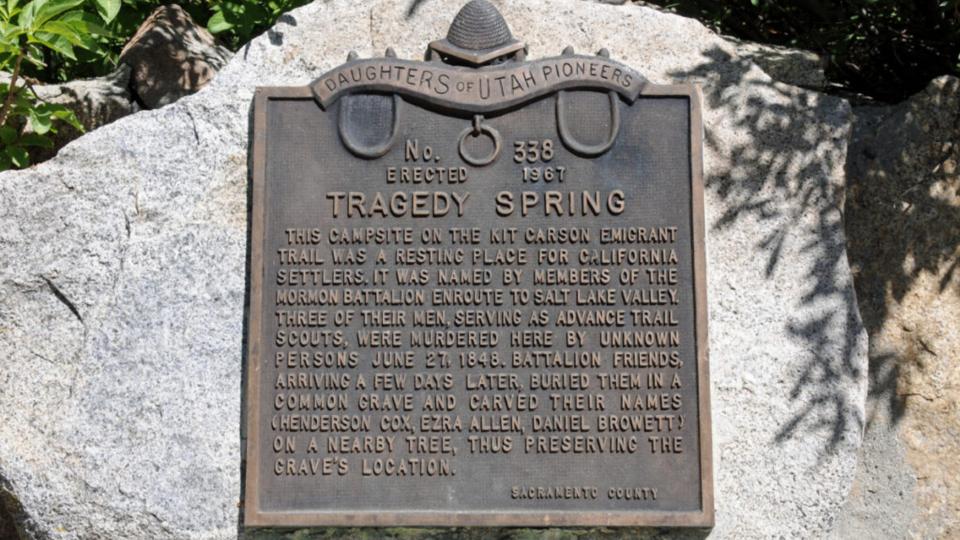
9 women in Church history
Memorial plaque at Tragedy Spring, where Melissa Burton Coray Kimball experienced the worst night of the entire journey on their way from California to Salt Lake City. As a newlywed, Melissa Burton Coray Kimball joined her husband William Coray in the Mormon Battalion as a laundress. Photo by Kenneth Mays, courtesy of Church News. All rights reserved.Who: Melissa Burton was born in Canada in 1828. She married William Coray in Nauvoo, Illinois, in 1846. Three months later, they began their service in the Mormon Battalion and its long march, 1846-1848.
Experience: Melissa traveled the entire length of the Mormon Battalion route with her husband, William. She was officially a laundress, who had to do laundry in addition to marching 2,000 miles with inadequate food and water. At times she kept a pebble in her mouth to help deal with the overwhelming thirst they all experienced at times. She kept that pebble for the rest of her life (see “The Mormon Battalion: U. S. Army of the West, 1846-1848,” by Norma Baldwin Ricketts, pages 186 and 208).
Following the Battalion’s formal discharge in July 1847 at Fort Moore, Los Angeles, Melissa and William headed north to spend some time with the Saints from the ship Brooklyn, who were settling at Yerba Buena, now San Francisco. At Monterey, Melissa gave birth to a baby son on October 2, 1847. They named him William, after his father. The child did not live long, passing away while they were still in Monterey.
After some time in San Francisco, Melissa’s group headed east in summer 1848. They had the arduous task of cutting a wagon road through the Sierra Nevada. On July 19 the group found the shallow grave of three advance scouts from their party. They had been killed by Indians. (See Melissa Burton Coray Kimball in “Utah Woman’s 2,000-Mile March Fifty-five Years Ago,” Salt Lake Herald, 26 May 1901, 2, on history.churchofjesuschrist.org.)
Melissa wrote and shared in “The Mormon Battalion”: “In all my journeys with the battalion, this was the worst night.” They called the site Tragedy Spring.
Melissa and William arrived safely in Salt Lake City, but the following year William died shortly after the birth of their baby daughter. Melissa eventually married William Kimball. She managed the Kimball Hotel, a stagecoach way station near Park City, Utah. The structure is extant and can be seen from I-80 near the Kimball Junction exit, named after her second husband.
Death: Melissa Burton Coray Kimball bore seven children by her second husband. She passed away on September 21, 1903. She is buried in the Salt Lake City Cemetery. There is a mountain peak named in honor of Melissa in the Sierra Nevada.
Sarah Melissa Granger Kimball: Creating a Ladies’ Society
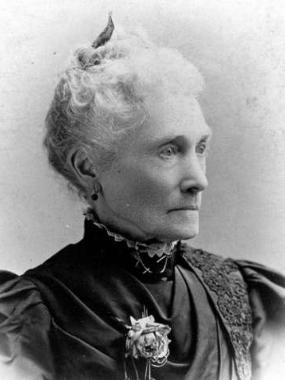
9 women in Church history
Sarah Granger M. Kimball played a role in the founding of the Relief Society. Photo courtesy of Deseret News Archives.Copyright 2021 Deseret News Publishing Company.Who: Sarah was born in 1818 at Phelps, New York. Her family joined the Church in 1830 and moved to Kirtland and eventually on to Nauvoo, Illinois. Sarah married Hiram Kimball, a prominent businessman. He joined the Church several years later.
Experience: Having some means and a comfortable home, Sarah offered to provide the material if her seamstress would make some shirts for the men working on the Nauvoo Temple. Other women were invited to participate, and soon there was a suggestion of creating a ladies’ society with a constitution and bylaws. Eliza R. Snow drafted a formal constitution to guide the ladies’ society in its objectives. When the Prophet Joseph Smith learned of this undertaking, he said their “offering is accepted of the Lord,” but took it all a step further by organizing a society for the sisters “under the priesthood after the pattern of the priesthood.” He went on to say, “The Church was never perfectly organized until the women were thus organized.” The Relief Society was formally organized on March 17, 1842. The Prophet instructed the sisters that “the society’s first obligation was to provoke the brethren to good works in looking to the wants of the poor — searching after objects of charity, and administering to their wants.” Women who wanted to join the society were admitted individually when standing members vote to give them full fellowship. Her experience is shared in “In Blessing Others We Are Blessed,” by Virginia H. Pearce, in “Women of Faith in the Latter Days Vol. 1” and “Nauvoo: A Place of Peace, a People of Promise,” by Glen M. Leonard.
In death: Sarah’s husband, Hiram, was killed in 1863 while serving a mission for the Church. She lived 35 more years. Although she did not serve in the Relief Society presidency during the Nauvoo period, Sarah served in the Relief Society both on the ward and general level for the Church while living in pioneer Utah. Sarah was serving as third counselor in the Relief Society general presidency at the time of her death in 1898.
Aurelia Spencer Rogers: Starting Primary for Children
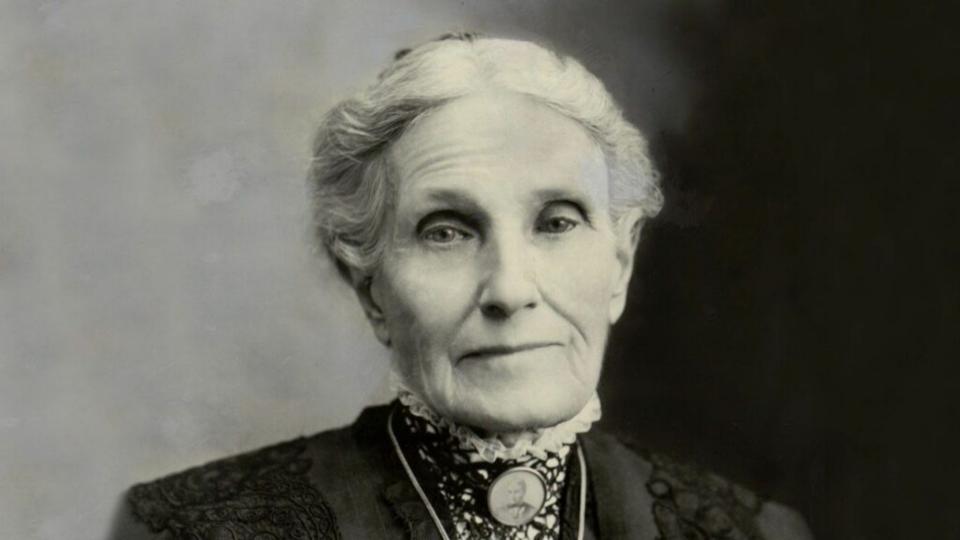
9-women-in-Church-history
Aurelia Spencer Rogers, as a wife and mother in Farmington, Utah, helped start an organization for children to help instill values and better behavior that became known as Primary. Photo courtesy of Church History Library.2021 Intellectual Reserve, Inc. All rights reserved.Who: Aurelia Read Spencer was born in Connecticut in 1832. Her family all joined The Church of Jesus Christ of Latter-day Saints when she was a young girl of 6. The family moved to Nauvoo in 1841. Aurelia remembered: “Then we had parents to love and care for us, and help us with our lessons while going to school,” she notes in “Life Sketches of Orson Spencer and Others.” She always recalled being lifted to a window of the Mansion House so that she could enter and see the martyred bodies of Joseph and Hyrum Smith.
Experience: Following the death of the Prophet Joseph Smith, the Spencer family joined thousands of other Saints in the exodus from Nauvoo. After not many miles into the journey, Aurelia’s mother died near Keosauqua, Van Buren, Iowa Territory. The county courthouse standing at that time is extant. Her father was called to preside over the British Mission, leaving the Spencer children to manage for themselves in Iowa. Aurelia’s 14-year-old sister, Ellen, acted as mother. Aurelia was second oldest at age 13. The children journeyed to Utah in 1848.
Years later as a wife and mother in Farmington, Utah Territory, Aurelia noticed inappropriate behaviors manifested by many of the children of parents who had been driven from various states, suffered much while crossing the Plains, and who were then struggling to make a living. She pondered the possibility of some kind of a children’s organization that could instill better values and behaviors in the boys and young men. She presented her thoughts to general Relief Society leaders who in turn delivered them to President John Taylor, who was leading the Church as President of the Quorum of the Twelve Apostles at that time. Beginning in 1878, Aurelia presided over the first ward Primary organization in the Church. Primary organizations spread all over the Church. Aurelia served in her ward and stake Primary organizations as well as other assignments with Sister Louie B. Felt, who served as general president for more than 40 years. Her experiences are shared in RoseAnn Benson, “For the Best Good of the Children,” by RoseAnn Benson in “Women of Faith in the Latter Days: Vol. 2” edited by Turley and Nash.
Life: Aurelia bore 12 children; five died when they were very young. She noted that the one time in her life, “when my children were taken from me by death, and I did almost question the existence of a God, was momentary.” Aurelia passed away in 1922 in Farmington. She was buried in the Salt Lake City Cemetery.
— Kenneth Mays is a retired instructor in The Church of Jesus Christ of Latter-day Saints’ Department of Seminaries and Institutes. His image collection is available at catalog.churchofjesuschrist.org.
Copyright 2021 Deseret News Publishing Company